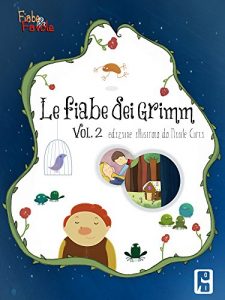Grimm's Fairy Tales, by Jacob and Wilhelm Grimm (The Brothers Grimm), is part of the Literary Classics Collection, which offers quality editions at affordable prices to the student and the general reader, including new scholarship, thoughtful design, and pages of carefully crafted extras. Here are some of the remarkable features of the Literary Classics Collection:
- New introductions commissioned from today's top writers and scholars
- Biographies of the authors
- Chronologies of contemporary historical, biographical, and cultural events
- Footnotes and endnotes
- Selective discussions of imitations, parodies, poems, books, plays, paintings, operas, statuary, and films inspired by the work
- Comments by other famous authors
- Study questions to challenge the reader's viewpoints and expectations
- Bibliographies for further reading
- Indices & Glossaries, when appropriate
All editions are beautifully designed and are printed to superior specifications; some include illustrations of historical interest. The Literary Classics Collection pulls together a constellation of influences—biographical, historical, and literary—to enrich each reader's understanding of these enduring works.
Grimm’s Fairy Tales—a trove of delights and insights that has been entertaining both young and old since the early 1800s—is literature at its most basic and wonderful. With the famous words “Once upon a time,” Jacob and Wilhelm Grimm immediately transport readers to a magical realm where witches, giants, princesses, kings, fairies, goblins, and wizards walk the earth.
When the Brothers Grimm set out to collect stories, their goal was to preserve Germanic folktales—not amuse young children. The hard life of central European peasants was reflected in the often violent and cruel nature of their folktales. However, once the brothers saw how the tales entranced young readers, they began softening some of the harsher aspects to make them more suitable for children. Now beloved the world over, Grimm’s Fairy Tales is a cornerstone of Western culture.
This collection of over 120 of Grimm’s most beloved tales includes such timeless classics as “Cinderella,” “Snow White,” “Hansel and Grethel,” “Rapunzel,” “Rumpelstiltskin,” “Little Red Riding Hood,” and “The Frog Prince.” Rich in sense and imagery, these legendary stories still have the power to surprise and enchant.
“It is hardly too much to say,” remarked W. H. Auden, “that these tales rank next to the Bible in importance.”
Unlike Andersen, the Grimms did not invent new tales but collected old ones, with the intention of preserving the oral tradition of the German peasantry. Whether in fact they fulfilled that intention has been questioned. Their tales do afford a glimpse of a world of castles and forests, nobles and peasants, superstitious beliefs and primitive practices that suggest origins at least as old as feudal Europe, and often much older. Some of the tales have been traced back through the centuries by way of earlier versions until they disappear into prehistoric times.
- New introductions commissioned from today's top writers and scholars
- Biographies of the authors
- Chronologies of contemporary historical, biographical, and cultural events
- Footnotes and endnotes
- Selective discussions of imitations, parodies, poems, books, plays, paintings, operas, statuary, and films inspired by the work
- Comments by other famous authors
- Study questions to challenge the reader's viewpoints and expectations
- Bibliographies for further reading
- Indices & Glossaries, when appropriate
All editions are beautifully designed and are printed to superior specifications; some include illustrations of historical interest. The Literary Classics Collection pulls together a constellation of influences—biographical, historical, and literary—to enrich each reader's understanding of these enduring works.
Grimm’s Fairy Tales—a trove of delights and insights that has been entertaining both young and old since the early 1800s—is literature at its most basic and wonderful. With the famous words “Once upon a time,” Jacob and Wilhelm Grimm immediately transport readers to a magical realm where witches, giants, princesses, kings, fairies, goblins, and wizards walk the earth.
When the Brothers Grimm set out to collect stories, their goal was to preserve Germanic folktales—not amuse young children. The hard life of central European peasants was reflected in the often violent and cruel nature of their folktales. However, once the brothers saw how the tales entranced young readers, they began softening some of the harsher aspects to make them more suitable for children. Now beloved the world over, Grimm’s Fairy Tales is a cornerstone of Western culture.
This collection of over 120 of Grimm’s most beloved tales includes such timeless classics as “Cinderella,” “Snow White,” “Hansel and Grethel,” “Rapunzel,” “Rumpelstiltskin,” “Little Red Riding Hood,” and “The Frog Prince.” Rich in sense and imagery, these legendary stories still have the power to surprise and enchant.
“It is hardly too much to say,” remarked W. H. Auden, “that these tales rank next to the Bible in importance.”
Unlike Andersen, the Grimms did not invent new tales but collected old ones, with the intention of preserving the oral tradition of the German peasantry. Whether in fact they fulfilled that intention has been questioned. Their tales do afford a glimpse of a world of castles and forests, nobles and peasants, superstitious beliefs and primitive practices that suggest origins at least as old as feudal Europe, and often much older. Some of the tales have been traced back through the centuries by way of earlier versions until they disappear into prehistoric times.



![Baixar Little Red Riding Hood Presented by Frendees Dual Language English/Spanish [Translated] (English Edition) pdf, epub, eBook](https://br.99ebooks.net/wp-content/uploads/2017/05/51cMcLZkpdL-225x300.jpg)
![Baixar Sleeping Beauty La Bella Durmiente Presented by Frendees Dual Language English/Spanish [Translated] (English Edition) pdf, epub, eBook](https://br.99ebooks.net/wp-content/uploads/2017/05/51yiaXI26FL-225x300.jpg)
![Baixar Hansel and Gretel Presented by Frendees Dual Language English/Spanish [Translated] (English Edition) pdf, epub, eBook](https://br.99ebooks.net/wp-content/uploads/2017/05/51hMLbNSYfL-225x300.jpg)
![Baixar Rapunzel Verdezuela Presented by Frendees Dual Language English/Spanish [Translated] (English Edition) pdf, epub, eBook](https://br.99ebooks.net/wp-content/uploads/2017/05/51NXkbQBKSL-225x300.jpg)





